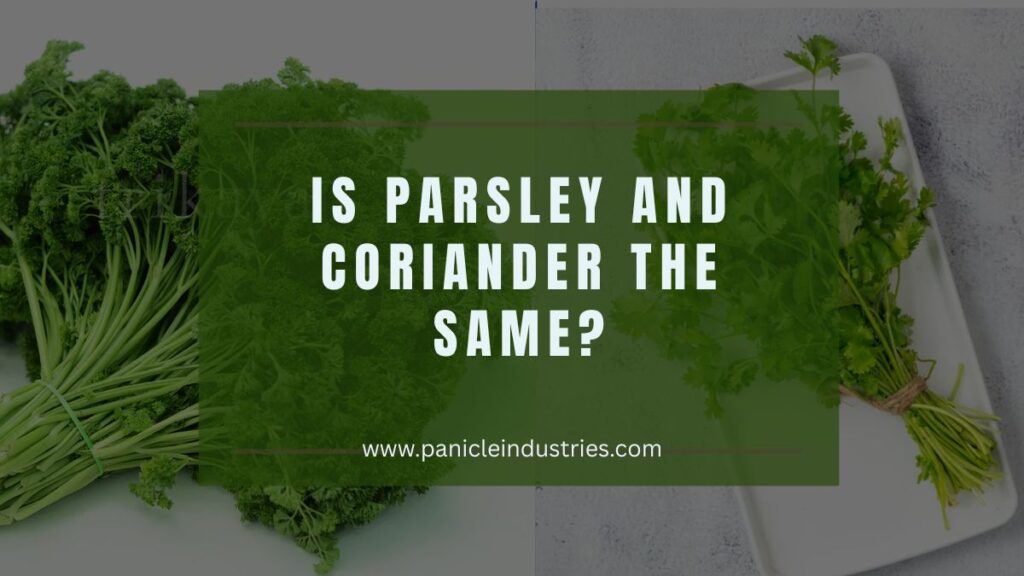Herbs add freshness, flavor, and nutrition to our food, and two of the most commonly used green herbs in global cuisine are parsley and coriander. However, many people often wonder — is parsley and coriander the same? This question is quite common, especially for those who are just beginning to explore cooking or trying out international recipes. At first glance, both herbs look similar with green leafy tops and similar textures. But in reality, they are quite different in terms of flavor, aroma, usage, and even nutritional content.
In this blog, we will explain is parsley and coriander the same, how to identify them, where they are used in cooking, and why it’s important to use the right one in your recipes.
What Is Parsley?
Parsley is a leafy green herb that belongs to the Apiaceae family. It is native to the Mediterranean region and is widely used in European, Middle Eastern, and American cuisines. There are two main types of parsley:
- Curly Parsley: Bright green with tightly curled leaves
- Flat-leaf Parsley (Italian Parsley): Flatter, broader leaves with a stronger flavor
Key Features:
- Mild, fresh, slightly peppery taste
- Commonly used raw or as a garnish
- Rich in vitamins A, C, and K
- Often found in salads, soups, sauces, and dressings
Also read: Are Coriander and Cilantro the Same Thing?
What Is Coriander?
Coriander, also from the Apiaceae family, is known by different names in different parts of the world. In the United States, the leaves are called cilantro, and the seeds are referred to as coriander seeds. In India and the UK, both leaves and seeds are usually called coriander.
Key Features:
- Leaves are soft, delicate, and fragrant
- Strong, citrus-like aroma and taste
- Used widely in Indian, Mexican, and Asian cuisines
- Leaves, stems, and seeds are all edible
Is Parsley and Coriander the Same?
Now to address the main question: Is parsley and coriander the same?
No, they are not the same herb. Although they look somewhat similar and belong to the same plant family, they differ in:
- Flavor
- Aroma
- Culinary use
- Nutritional profile
Here’s a quick comparison to help you understand:
| Feature | Parsley | Coriander (Cilantro) |
|---|---|---|
| Origin | Mediterranean region | Southern Europe, Asia |
| Taste | Mild, grassy, peppery | Strong, citrusy, slightly spicy |
| Aroma | Subtle and fresh | Sharp and bold |
| Appearance | Curly or flat leaves | Flat, delicate leaves |
| Common Use | Garnish, salads, soups | Curries, chutneys, salsas |
Flavor Comparison
One of the biggest differences between the two herbs is flavor.
- Parsley has a milder taste, making it suitable for garnishing and flavoring light dishes like soups, pasta, and baked items.
- Coriander (cilantro) has a stronger flavor with a citrusy kick, making it ideal for spicing up dishes like curries, tacos, and chutneys.
Some people even find the taste of coriander unpleasant due to a genetic trait that makes it taste like soap.
Culinary Uses of Parsley and Coriander
Common Uses of Parsley:
- As a garnish on pasta, pizza, and grilled meat
- Mixed into fresh salads like tabbouleh
- Blended into herb sauces like chimichurri or gremolata
- Added to soups and stews for mild flavor
Common Uses of Coriander:
- Mixed into spicy Indian curries and dals
- Chopped fresh into salsas and guacamole
- Used in Thai and Vietnamese salads
- Ground coriander seeds are used in spice blends like garam masala
Using one in place of the other can change the flavor of the dish significantly.
Nutritional Comparison
Both parsley and coriander are rich in nutrients, but in slightly different ways.
Parsley:
- Rich in vitamin K (good for bones and blood)
- Contains vitamin C and iron
- Good source of antioxidants
Coriander:
- High in vitamin A (for vision and skin)
- Contains vitamin C and calcium
- Also has antioxidants and digestive benefits
Both herbs offer health benefits and are great additions to a balanced diet.
Regional Names That Cause Confusion
In many countries, the terms used for coriander and parsley can create confusion.
- In the USA and Canada, coriander leaves are called cilantro.
- In India, the UK, and Australia, the same leaves are simply called coriander.
- Parsley is just parsley in most places, but the type (curly or flat) may differ.
If you’re following recipes from different regions, always double-check whether the recipe means coriander leaves, coriander seeds, or parsley.
How to Identify Parsley and Coriander
Visual Cues:
- Parsley leaves are usually more rigid and may be either curly or flat.
- Coriander leaves are softer, more delicate, and resemble carrot tops.
Smell Test:
- Parsley has a mild aroma that’s not too strong.
- Coriander smells sharp and citrusy, sometimes even a little sweet or spicy.
If you’re unsure while shopping, take a small whiff—your nose can tell the difference!
Storage and Shelf Life
Storing Parsley:
- Wrap in a damp paper towel and place in the refrigerator
- Can also be frozen in airtight containers for long-term use
Storing Coriander:
- Best stored upright in a glass of water with a plastic cover
- Should be used within a few days for best flavor
Proper storage helps keep herbs fresh and flavorful for longer periods.
Can You Substitute Parsley for Coriander?
In general, parsley is not a good substitute for coriander and vice versa.
- Parsley lacks the bold, citrusy flavor of coriander and will not add the same depth to spicy dishes.
- Coriander may overpower dishes that call for the subtle touch of parsley.
If a substitute is needed:
- For coriander leaves, try basil or mint (in moderation).
- For parsley, chives or celery leaves might work for garnishing.
Fun Facts
- Parsley is often used as a natural breath freshener.
- Coriander seeds were found in ancient Egyptian tombs.
- In traditional medicine, coriander is believed to aid digestion and detoxification.
- Parsley tea is sometimes used to reduce bloating.
These herbs are not only flavorful but also carry a rich history in both food and medicine.
Conclusion
To answer the question clearly—is parsley and coriander the same? The answer is no. While they look similar and come from the same plant family, their flavor, aroma, and culinary uses are quite different. Parsley is mild and often used as a garnish, while coriander (especially its leaves, also known as cilantro) has a strong, citrusy flavor used in bold dishes. Knowing the difference between the two is essential for cooking the right recipes with the right taste. Next time you’re in the kitchen or shopping for herbs, you’ll know exactly what each one brings to the table—and you’ll avoid the common mistake of confusing the two.


